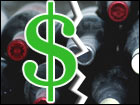
NEW YORK (CNN/Money) - It's a wide world of wine out there, and you can enjoy it many ways. Ordering a glass of wine with dinner makes a good meal taste superlative. Attending a wine tasting can be fun (although you're supposed to taste the wine and spit it back out). Some folks even work with wines -- they own a wine shop, stock good bottles to restaurants, or even have a vineyard.
| |
 Related stories
Related stories
| |
| | |
| | |
|
Still others collect rare, old and expensive wines, much the same way people collect valuable art, coins, or stamps. If you're a serious wine collector, you should think about insuring your wine, just as you would buy insurance for a painting or an expensive piece of jewelry. You wouldn't want to end up empty-handed should a valuable bottle hit the cellar floor or simply go bad.
Choosing a policy
"In order to decide on appropriate insurance, you have to distinguish between the collector and the connoisseur," said Mary Ann Avnet, a spokesperson for the Chubb Group. "You may have what many call a collection, but keep your wines primarily for consumption purposes. You're not necessarily buying wine because it's rare. But the true collector will be buying rarities and portions of small supplies."
If your collection is relatively small, not too expensive and primarily for consumption, insure your wines under your homeowners' policy. Just check to make sure you have enough contents coverage in your policy to cover the wines.
If your collection is substantial, however, you should probably invest in a stand-alone, "valuable articles" policy for your wine, which give you broader coverage than your home policy does. Insurance companies like Chubb Group and AXA Art Insurance sell these policies.
Wine collectors have two options when selecting their policy, Avnet said. They can insure the collection up to a certain blanket amount. But after someone has a collection worth more than about $10,000, it starts to make sense to insure the wine on an itemized basis -- bottle by bottle.

Itemizing your wine policy requires getting your wine appraised; you insure each bottle for its appraised value.
"You can look in the classifieds in the back of any wine magazine, and there will be ads for wine appraisers," said Ed McCarthy, co-author of "Wine for Dummies" with his wife, Mary Ewing-Mulligan, M.W. "You can also find current prices in wine auction catalogs for Christy's and Sotheby's or catalogs from large retail stores, like Sam's in Chicago or Sherry Lehmann in New York City."
A stand-alone wine policy will cost you about 40 to 50 cents for every hundred dollars' worth of wine, McCarthy said. If you had a wine collection worth $75,000, you would pay an annual insurance premium of about $315.
What's covered
Before you buy stand-alone wine insurance, however, think about specific perils and scenarios.
"Generally, collectors will be most worried about fire, theft, and breakage," Avnet said.
Do you want coverage for label damage, even if the wine is intact? Will you be covered if the wine is "corked" (a chemical development in the cork that changes the wine's taste, said to affect about 5 percent of all bottles)? Do you need coverage in multiple locations? If you keep the wine in a temperature-controlled cellar, will the policy also cover temperature changes or a breakdown in climate control equipment?
"Keep in mind the four enemies of wine: vibration, heat, excessive humidity and light," said Bill Edgerton, a wine appraiser and consultant for the American Society of Appraisers. "Wine insurance will be more expensive than just using your home policy, but will give you more coverage when facing these kinds of problems."

|

